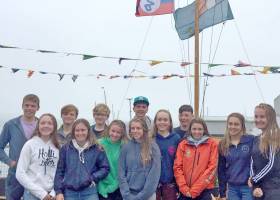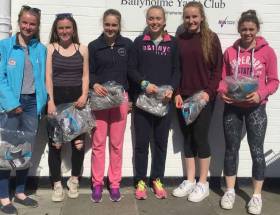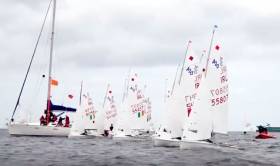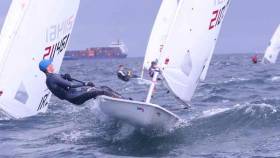Displaying items by tag: 420
420 Introduction Day at Malahide Yacht Club Gives Sailors First Taste of 'Pathway' Dinghies
Sunshine on Saturday greeted the groups of sailors taking part in the first of the 420 sailing introduction days. Groups of six sailors used the class association training boats to get their first taste of sailing in these Irish Sailing Performance Pathway boats. Sailors had the option of two hour sessions in either the morning or afternoon, both sessions coached by experienced 420 sailors who took sailors through the basics of boat set up and handling.
Sailors from Malahide Yacht Club, Howth Yacht Club, Greystones Sailing Club and the National Yacht Club took part in this first introductory day. The next introductory day will also be held at Malahide Yacht Club on Saturday the 14th October, a small number of places are still available for this second day and any sailors wishing to attend should email [email protected] to make enquires on availability.
420 Dinghy Winter Training Begins Across Ireland
With the first 420 open training session due to start on the 28th, 29th and the 30th October at the National Yacht Club in Dun Laoghaire this weekend saw a start in earnest to 420 winter training programmes around the regions. Clear sunny skies on Sunday greeted the crews training in Dun Laoghaire whilst in Galway Bay Sailing Club the autumn training programme has also commenced. The upcoming RYA Youth Nationals also saw 420s training under the RYA Open Pathway training in Northern Ireland and details of training in Cork are soon to be announced.
A number of enquiries from sailors wishing to try sailing the 420 has meant the Association have added an introduction day to the Autumn programme at Malahide Yacht Club using the Class Association boats.
The introduction day gives sailors the opportunity to sail 420s in small groups with an experienced 420 sailor on hand for advice.
For any sailors interested in attending the introduction day at Malahide or other centres around the country please email [email protected] for details.
Irish 420 Dinghies Gear Up for Autumn Sailing Events, RYA Northern Ireland Youth Championships This Month
The summer might officially have drawn to a close but the Autumn still offers plenty of opportunity for sailing by 420 crews. First up is the RYA Northern Ireland Youth Championships on the 23rd and 24th September which is the last competitive racing this side of the Irish Sea this year.
Sailing continues with the running of an open training event on the 28th, 29th and the 30th October at the National Yacht Club in Dun Laoghaire on Dublin Bay. Entry for the open training will soon be available on the National Yacht Club website but if you have any questions regarding the training or if you wish to reserve a place early then please contact [email protected]. The training will be led by Graham Grant and it is open to all sailors, the fully equipped 420 class association boats will be available for rental during the training weekend for sailors who may not yet have acquired their own boats, reservation of boats can be confirmed with [email protected]
For any sailors who are considering the 420 as their next boat the association will also be offering the opportunity to come along and try the boat as part of an open day. Whether you wish to helm or try the thrill of crewing one of these performance pathway boats please contact [email protected] to find out more details.
The 420 Munster Championships were held at Waterford Harbour Sailing Club in Dunmore East last weekend in conjunction with the South Coast Championships of the Flying Fifteens (report here)
The sailors enjoyed an excellent weekend of racing that started in bright sunshine with a breeze of 15-20–knots that moderated as the racing progressed.
Four races were completed on the Saturday with Geoff Power and James McCann winning all four races. The top dinghy pair previously finished in pair in the top ten at 420 Kiel Week Regatta in June.
Sunday's racing provided a contrast in weather with a constant drizzle and a switch in wind direction bringing a large swell into Dunmore East to add further excitement to the downwind legs with plenty of surfing in evidence. The speed of the 420 crews around the course, both upwind and downwind, provided an exciting spectacle for those watching from the harbour wall. Two races were completed on Sunday with Geoff Power and James McCann completing a perfect series in the Gold fleet by also winning the final two races.
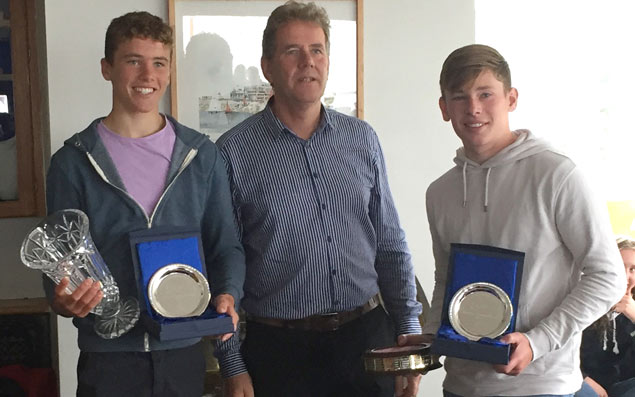 Geoff Power and James McCann collect their trophies at WHSC
Geoff Power and James McCann collect their trophies at WHSC
Silver fleet was won by Sarah Levie and Emily Whitaker.
The results of the Gold and Silver fleets are as follows:
Gold Fleet
1st Geoff Power WHSC/ James Mc Cann RCYC
2nd Gemma Mc Dowell/Emma Gallagher MYC
3rd Nicola Ferguson. Fiona Ferguson NYC
Silver Fleet
1st Sarah Levie LRYC/ Emily Whitaker RCYC
2nd Lucy Bell SLYC/Emma Greer SLYC
3rd Dara Donnelly / Cliona Coyle NYC
Full results sheet is downloadable below
Irish Sailing’s New Club Coaching Programme
Ross Killian is Irish Sailing’s 420 Academy Coach, but this summer Killian is also developing a new Club Coaching programme. Afloat.ie finds out more about the Club Coaching programme and what he’s looking for.
What’s the new Irish Sailing Club Coaching Programme all about?
We know that most children learn to sail during the summer on various Irish Sailing courses, but we wanted to put a programme in place that steps up a level and teaches children how to race, and at the same time, extends their time on the water after the summer months. The aim is threefold: teach younger sailors about racing, get more clubs and coaches interested in race coaching, and extend the summer season into the autumn.
The Club Coaching programme has two parts. The first is finding suitable instructors and coaches on the ground and bringing them up to a brand new Irish Sailing certification called “Club Coach Level 1”. The second is working with the clubs to design a tailor-made programme that takes into account club size, costs, boats available, and geographic spread.
What does this mean for Clubs?
This summer we are rolling out the programme for clubs to encourage them to nominate possible coaches. I also want to work with as many clubs as possible to create their own Club Coaching programme. If Clubs can include a club coach in their offering to members, we can encourage more children to learn about racing, extend the on-the-water season for sailors, and expand the pool of coaches. For example, if you are a mid-sized club and you have seven Toppers that have sailed all summer, why not get a coach to train up to Club Coach Level 1 and offer weekend race training after all the summer courses have finished – you could extend your season for three or four weeks in September and October. If you have a smaller fleet, you could think about teaming up with another club in your region and splitting the coaching sessions. I’m here to help with creating and tailoring these programmes.
What would you like to have achieved by this time next year?
By next year I’d like to have ten clubs actively running coaching programmes, and thirty valid and practicing trained coaches who are suitable to deliver club coaching.
What are you looking forward to most about this role?
I’m passionate about coaching and passionate about sailing, and I am looking forward to working with others to deliver the best training sessions to their young sailors.
Training for the new Club Coach Level 1 will begin in the autumn. If you’d like to find out more, please contact Ross Killian at [email protected]
Dunmore East Dinghy Pair In Top Ten at 420 Kiel Week Regatta
In the same weekend that Dunmore East ICRA sailors won the Sovereign's Cup, Waterford Harbour dinghy sailors were strutting their stuff on the international dinghy circuit. Geoff Power and James McCann took a creditable seventh overall in a massive 135–boat 420 fleet at Kieler Woche in Germany.
Earlier this season, Power and McCann, in their first year in the 420 together, secured top spot at the ISA Youth Pathways in Ballyholme in April.
Dun Laoghaire sisters Nicola and Fiona Ferguson were 83rd, Gemma McDowell and Emma Gallagher were 90th and Grace O'Beirne (nursing a shoulder injury) and Kathy Kelly were 104th.
The crews return to Cork this weekend for the Irish 420 Championships as part of Royal Cork's Dinghy Fest.
More results on the Kiel Week website here
Malahide Girls Top 420 Ulster Championships
Nearly 30 sailors attended the joint 420 and Fireball Ulster Championships last weekend with a mixture of conditions to test out the sailors writes Mark Mackey. Most of the visitors travelled up from Cork and Dublin to compete in the two different classes – both are double handed dinghies with a single trapeze wire for the crew, but there the similarities end.
The 420 is a rounded more plastic style mini version of the 470 class which is sailed at the Olympic Games by both male and female crews. The 420 is used as a youth pathway class and many of the teenage sailors had already visited Ballyholme over Easter at the ISA Youth Championhips. All-girl crews dominated the event despite the strong winds on Saturday, occupying the first 3 places overall. It was great to see local sailor Adam Lockart getting a run out having struggled to find a regular crew – Daniel Thompson from Wexford Harbour helped out this weekend.
The Fireball is a much sleeker craft orginially built in wood – in fact many were built in the Ballyholme chnaging rooms over the winters back in the 1970's. These days they are glass-fibre with lots of controls and tweaks to be made whilst racing. As opposed to the teenage crews of the 420's, the Fireball attract the older generation with many of the sailors well into their 60's and some their 80's – a marvellous example of the length of time that people can continue to compete and enjoy sailing. These are not sedentiary boats however with big mainsails that power them up to speeds that are only surpassed by the Olympic skiffs and multihull dinghy classes. See Fireball class report here.
After Saturday's breeze and lumpy seas, the sunshine came out for Sundays races with a light 5-8 knot breeze and flat water. A range of conditions is always useful to test out the best sailors who still manage to excel no matter what they are faced with. Malahide's Gemma McDowell and Emma Gallagher followed their second place 2 weeks ago with top of the podium in the 420 class, while Noel Butler and Stephen Oram are no strangers to the top of the Fireball fleet either. Both classes gave their thanks to the club, sponsor P&O Ferries and Race Officer Robin Gray.
420 Ulsters:
1st Gemma McDowell and Emma Gallagher, Malahide YC
2nd Grace O'Beirne and Kathy Kelly, Royal St George YC
3rd Nicola and Fiona Ferguson National YC
ISA Youth Sailing Video from Ballyholme YC Here
Ballyholme Yacht Club has released a video of all the weekend action from Bangor Bay, the largest entry ever for the ISA youth national championships.
Read our full report here and see the latest video moments below:
Irish Youth Sailing's Selection Process is a Serious Business
Its full title is the Irish Sailing Association Youth Pathway Nationals and Optimist Trials. It is a designation with a great air of seriousness about it, contrasting markedly with current public debate about providing more fun sailing, while making regattas as much about sport and enjoyment afloat and ashore as they are about winning.
Yet from time to time, sailing does have to be serious – deadly serious – if we’re going to have any more significant international medals such as those won at the Olympics by Annalise Murphy, at the Laser Radials Worlds by Ewan McMahon,, and at the ISAF Youth Worlds by Doug Elmes and Colin O’Sullivan. The way those great achievements - hard won through a very serious training and participation programme - were able to immediately lift the public mood with their clearcut international success deserves full recognition. W M Nixon tries to put it into perspective for those whose own sailing does not aspire to the giddy international heights.
When you look at that title of “Youth Pathway Nationals and Optimist Trials”, you wonder that as many as 190 boats in six different classes have turned up at Ballyholme for the four days of racing. For there’d been a certain collective madness beforehand, with some folk talking of beyond 200 or even up to 250 boats. But that could be put down to an excess of exuberance following the impressive turnout of 125 Lasers for the Munster at Baltimore.
 On a tight spinnaker reach in Ballyholme Bay, McDowell and Gallagher narrowly lead the 420s from Heather Spain and iseult Kneafsey of the National, with Lucy Kane and Grace Jennings (East Antrim) next in line. Photo: Mark Mackey
On a tight spinnaker reach in Ballyholme Bay, McDowell and Gallagher narrowly lead the 420s from Heather Spain and iseult Kneafsey of the National, with Lucy Kane and Grace Jennings (East Antrim) next in line. Photo: Mark Mackey
For that was - for many - a fun event in a fun place, with a fun fleet except for maybe the top ten - and even they were frequently seen to laugh. And for sure, there are kids who are having a ball at Ballyholme right now. But for just this one long weekend of the year, there are serious moves being made which will decide the development of junior sailing at the top level in the year ahead, and in many of the years beyond that. We should be worried if it weren’t so brutally focused, rather than being unduly concerned about junior sailing becoming too serious.
That said, the seriousness produces its lighter moments, though you could sympathise with the Topper person who noted that there are five Topper places up for grabs for admission to the Topper Pathway Scheme, yet there are 32 Toppers (39 including the 4.2s) racing their little hearts out at Ballyholme. “What are we going to say?” asked this conscience of the Topper class, “What are we going to say to the young skippers who come 6th, 7th and 8th.....?”
Then there was the Optimist dad who arrived into the Race Office letting the world know that his family’s budget for the event was already shot to ribbons. Heaven only knows what the accommodation pressure would have been like if the more optimistically anticipated fleet of 250 boats with all classes had all turned up. For as it is, accommodation pressures have resulted in people being forced to rent houses for the week – for there’s no way you can get a rental starting on a Wednesday night – and deciding that the sensible thing is to come for a week’s holiday for the whole family. Inevitably, it means lots of money running out the door before the one or two family members who are actually racing start their proper sailing.
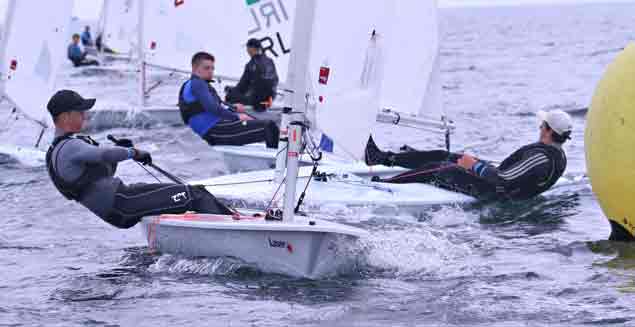 After two days Ewan MacMahon of Howth has the overall lead in the Laser Radials. Photo Mark Mackey
After two days Ewan MacMahon of Howth has the overall lead in the Laser Radials. Photo Mark Mackey
So anyway this Opty dad is telling anyone who is listening that the budget is already shot with the family spending a whole week in a house in a village he’d never heard of before. But now, worse still, somebody has just told him that his daughter is seen as one of the rising stars of the class, and they wouldn’t be surprised, once this weekend’s racing is finished, to see her name down as a potential member for the Irish squad at the Optimist Worlds 2017 at the Royal Varuna Yacht Club in Thailand in July.
“And do you know what that means?” he demands. “It means that if we accept that offer of a place at the Worlds, within a week we have to divvy up €2,000 for the International Optimist Dinghy Association of Ireland. I can tell you something” he continues, now in full flight, “if she’s anywhere within range of a place with only one or two races still to go, we’ll be seriously thinking of feeding her a dodgy chicken sandwich.....”
Such are the joys of being an Opty dad. And it was something to contemplate along with the fondest recollections at an event on Thursday night in my own home club of Howth, when friends from times past – some of them friends from very long times past – joined with the great and the good including ISA President Jack Roy and his wife Rosemary, and HYC Commodore Joe McPeake – together with a whole raft of former HYC Commodores – to celebrate the award by World Sailing (formerly ISAF) of a Gold Medal to Howth’s own Helen-Mary Wilkes for her decades of service to the International Optimist Dinghy Association worldwide.
 At the conferring of Honorary Membership of Howth Yacht Club on Helen-Mary Wilkes in celebration of her Gold Medal from World Sailing are (left to right) Jack Roy (President, Irish Sailing Association), Joe McPeake (Commodore Howth YC, who is holding a copy of Robert Wilkes’ History of the International Optimist Class,) Helen-Mary Wilkes, and Robert Wilkes. Photo: John Deane
At the conferring of Honorary Membership of Howth Yacht Club on Helen-Mary Wilkes in celebration of her Gold Medal from World Sailing are (left to right) Jack Roy (President, Irish Sailing Association), Joe McPeake (Commodore Howth YC, who is holding a copy of Robert Wilkes’ History of the International Optimist Class,) Helen-Mary Wilkes, and Robert Wilkes. Photo: John Deane
Her international career started when it was noted that she was the key player as Secretary of the Organising Committee when Howth ran the Optimist Worlds in 1981. After that, Helen-Mary’s international service was of such quality and duration that her most recent years with the IODA have been as President of Honour. For, in the many years she was actually running it all on a day-to-day basis with the backroom support of her husband Robert, they saw an increase of 78% in international membership of the world association to bring the total to 87 countries, and 57 of those countries regularly took part in international championships, while boat numbers increased stratospherically.
It was by no means an easy ride, for with main builders in several countries and different continents, the Optimists were by no means totally One-Design. But fortunately Helen-Mary Wilkes had the very man in Ireland with the skill, patience and diplomacy to sort this out - David Harte of Schull, at that time a Howth resident. As an Optimist builder himself, “Harty” knew everything about these very important little boats, and between 1995 and 1997 he was on an almost continuous worldwide mission to persuade the eight main builders to standardise the class to the highest One-Design requirements, an objective in which he succeeded.
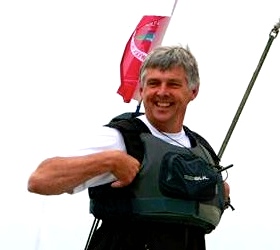 David Harte of Schull, who in 1995 -1997 was instrumental in ensuring that the eight production builders worldwide of the International Optimist Dinghy were producing a truly One-Design boat.
David Harte of Schull, who in 1995 -1997 was instrumental in ensuring that the eight production builders worldwide of the International Optimist Dinghy were producing a truly One-Design boat.
David Harte being one of these people who seems ageless, it takes a bit of an effort to realize that he was doing this all of twenty years ago. But the result has been a much more total global acceptance of the Optimist. And in speaking to Thursday night’s gathering, Helen-Mary and Robert Wilkes addressed people’s concerns that the current event in Ballyholme, and other major Optimist championships in Ireland, are becoming too serious for the good of the young sailors.
“We’re every bit as interested in the kids who are into Optimists just for club racing and local sailing as we are for the high flyers. Over Easter, there are five major Optimist regattas under way at different venues in Europe. In all, more then 4,500 Optimists are sailing at every possible level of competition in these events. Yet at none of those regattas is selection for special strands of training under way. Ultimately, it is all about sailing for sailing’s sake. It only happens to be the case that it’s in Ireland the Easter Regatta is also being used for the trials. Inevitably, there’s criticism that the kids are being put under too much pressure here. But as a matter of policy, the International Optimist Dinghy Association is as interested in friendly local racing as it is in international competition”.
 “Get ’em up and move ’em out....” Optimists and Lasers swing into the launch sequence at Ballyholme. Photo: Pierce Purcell Jnr
“Get ’em up and move ’em out....” Optimists and Lasers swing into the launch sequence at Ballyholme. Photo: Pierce Purcell Jnr
Meanwhile last night up at Ballyholme they were able to post two days of good racing results in westerly winds for the Laser Radials, 420s and Optimists, and one day of racing for the Toppers, Laser 4.7s and Topper 4.2s.
LASER RADIALS
After a 7th, 4th and 6th on Thursday, when Aaron Rogers of Rush SC was the overnight leader, Ewan MacMahon of Howth came back like a rocket yesterday and posted 1,1, and 2nd to leave him leadng on 14pts to the 20 of Henry Higgins of the Royal St George in second (4,(26) 2,4,2,8), with Johnny Durcan of Royal Cork finishing strongly with a bullet in yesterday’s concluding race for a scoreline of 2,8,10, (42 BFD) 3, 1 and a points total of 24. Rush SC pair of Conor Quinn and Aaron Rogers are next on 27 and 28 in a fleet of 43.
420
Geoff Power and James McCann of Dunmore East have recovered from an OCS yesterday to take over the lead in a healthy fleet of 16, they have totalled 6 points with a used scoreline of 2,1,1,1,1, with Gemma McDowell and Emma Gallagher of Malahide taking one of the two spare wins after the Power display of, well, power, the Malahide crew now lie second on 12 points, just one point ahead of the other race winners, Kate Lyttle and Niamh Henry of Royal St George.
OPTIMISTS
Justin Lucas (13) of Tralee and Royal Cork had been hotly tipped as the favourite for the Optimists, and he has certainly lived up to the billing with a scoreline of 1,1,(12),11,4,5,1 after two days of racing in a 62-strong fleet. There has been some post-racing re-arrangement of results with protest outcomes, but Lucas is well clear of Royal Cork’s Michael Carroll with 23 points to the 37 of Carroll in second, while James Dwyer Matthews (Cork & Kinsale) is tied on 40 with the leading junior Luke Turvey (Howth and National,) who goes to fourth on the higher discard. Leah Ricard of the National is top girl at 9th overall.
LASER 4.7
The National YC’s Clare Gorman leads after the first day of racing for the 4.7s, with a scoreline of 4,2, and 1 to give 7 pts against the 9 of Royal St George’s Jack Fahey in second, third slot being held by David Carroll of Kinsale & Crosshaven while Tom Higgins of RStGYC and Eva MacMahon of Howth tie on 16, but Higgins takes 4th on the discard in a fleet of 33.
TOPPER
Rob Keal of Royal Cork had a good first day of it yesterday to lodge two firsts and a fourth, giving him 6pts against the 11 of second placed Kate Fahy (RStGYC & Lough Derg) while East Down’s Sarah Jennings’ 13pts keeps her in third ahead of Royal Cork’s Conor Horgan on fourth in a fleet of 32.
TOPPER 4.2
Lewis Thompson of Ballyholme and Donaghadee has had three straight firsts to the three seconds of Ballyholme’s Hannah Dadley-Young, third overall is Donaghadee/Ballyholme’s Joshua McGregor with two hirds and a fourth while Adam Irvin of the Irish National Sailing School is fourth on 4,5,4.
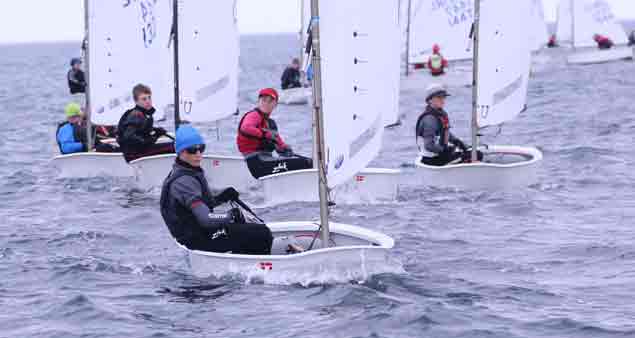 Justin Lucas of Tralee Bay is leading the 62-strong Optimist fleet. Photo: Mark Mackey
Justin Lucas of Tralee Bay is leading the 62-strong Optimist fleet. Photo: Mark Mackey
It is interesting to contemplate all this highly-regulated contemporary modern sailing on Belfast Lough, for it was far from Lasers and 420s and four days of intensive racing from committee boat starts that we were reared when we spent our first years afloat in and around Ballyholme Bay.
In those days, proper junior training and a structured junior racing programme weren’t so much in their infancy as barely a gleam in anyone’s eye. At a certain age – before any of us was even into our teens – we were given a new 14ft clinker sailing dinghy of the Ballyholme Insect Class, and told to get on with it on the assumption that, having sailed with adults in keelboats, we’d know how it was done.
 Steep learning curve. We weren’t even into our teens when we were presented with a 14ft Ballyholme Insect Class, and told to get on with it. Photo: W M Nixon
Steep learning curve. We weren’t even into our teens when we were presented with a 14ft Ballyholme Insect Class, and told to get on with it. Photo: W M Nixon
With a massive lack of imagination, we called her Grasshopper. In truth, Rockhopper would have been more on target. The distinctly exposed Ballyholme Bay is sheltered to the northeast, ’tis said, by Ailsa Craig, which is 40 miles away. Admittedly the bay has a decidedly featureless shoreline at low water, which limits sailing options even if you aren’t hampered by strong onshore winds. But when the tide is well in, all sorts of little islands and channels are created, and we learnt our sailing threading our way through this miniature maze of skerries.
 Ballyholme Bay at Low Water has a rather featureless shoreline....
Ballyholme Bay at Low Water has a rather featureless shoreline....
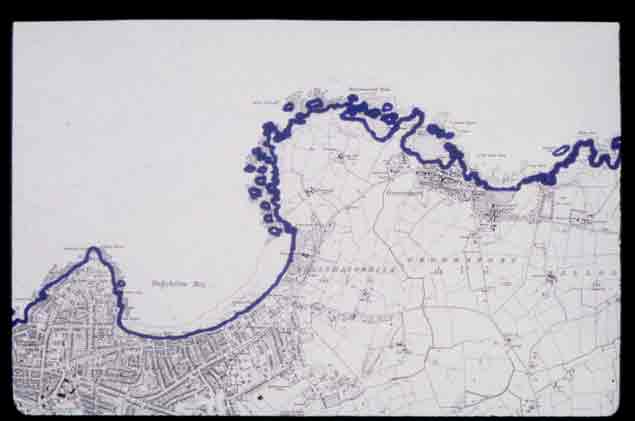 ....but at High Water it becomes a much more interesting place, with all sorts of islands and channels.........
....but at High Water it becomes a much more interesting place, with all sorts of islands and channels.........
 ......through which a sailing dinghy with centreplate half-raised can thread her way. Photo: W M Nixon
......through which a sailing dinghy with centreplate half-raised can thread her way. Photo: W M Nixon
There was of course no such thing as an accompanying rescue boat, but from time to time we sailed in consort with a friend whose boat was a smaller sister, a 12ft–clinker dinghy, but made more exotic with a little bowsprit.
Safety rules were few. We were expected to wear kapok lifejackets when actually sailing, but not otherwise, and they’d immediately be used as fenders if we came alongside rocks or small jetties. As for sailing limits, we were supposed to stay in Ballyholme Bay south of a line from Luke’s Point on the west side over to a rock called Jenny’s Isle off Ballymacormick Point to the northeast. However, at high water you could sail with the centreplate half up inside Jenny’s Isle and the tidal islets beyond it, so you could keep going east, while staying within that outer limit line, until you’d gone clean round the world.
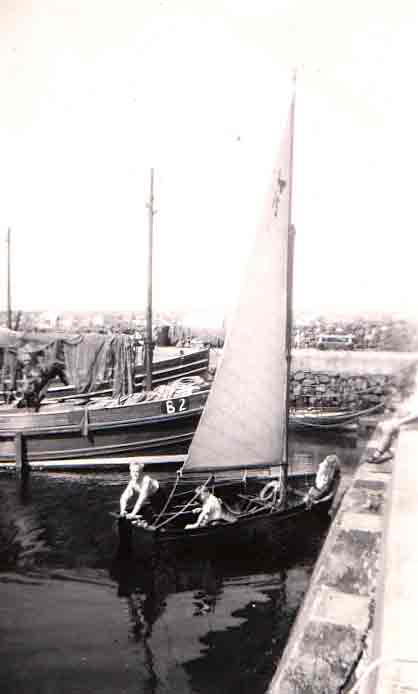 Groomsport, a little fishing harbour which was our first “foreign port.” It is less than two miles from the anchorage at Ballyholme Bay Photo: W M Nixon
Groomsport, a little fishing harbour which was our first “foreign port.” It is less than two miles from the anchorage at Ballyholme Bay Photo: W M Nixon
But there wasn’t that much mischief in us, so it was quite a day when official permission was given to sail all the way to the nearby fishing harbour of Groomsport, our very first Foreign Port of Call. And after that, the south shore of Belfast Lough from Orlock Point to Grey Point was our cruising paradise, and we’d disappear off for the entire day with a basic lunchbox and the hope of augmenting it with mackerel.
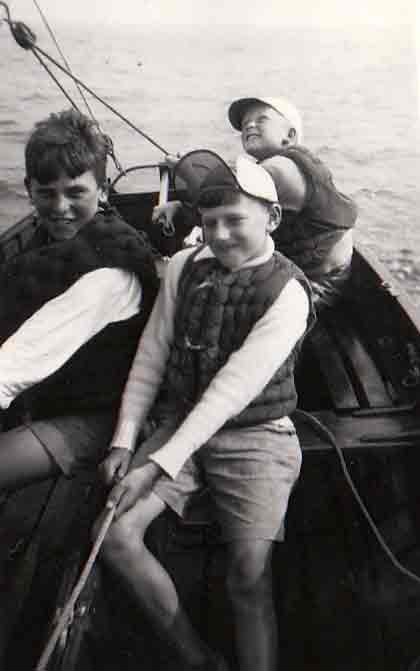 Off for a days cruising, with a lightly packed lunchbox and a couple of mackerel lines to augment the meal. Photo: W M Nixo
Off for a days cruising, with a lightly packed lunchbox and a couple of mackerel lines to augment the meal. Photo: W M Nixo
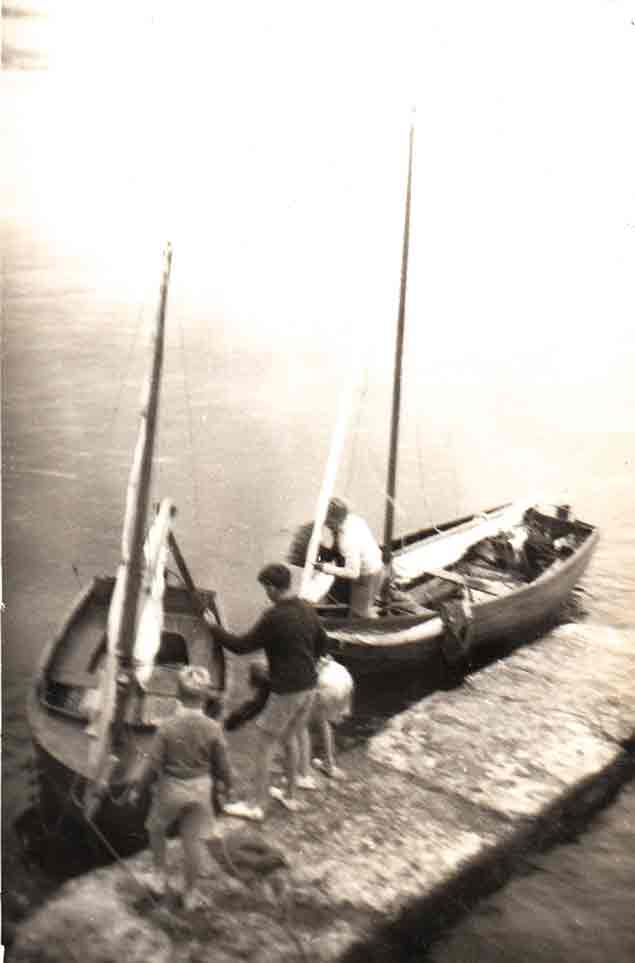 Cruise in company. The fleet gathers at Swinley Bay three miles west of Ballyholme, and lifejackets soon become fenders. Photo W M Nixon
Cruise in company. The fleet gathers at Swinley Bay three miles west of Ballyholme, and lifejackets soon become fenders. Photo W M Nixon
If the wind fell light in the evening, we could row home, and over the years nobody gave our daylong absences any thought. There were some close calls, but we never actually capsized the boat. Which was just as well, for if you capsized an Insect, she stayed capsized, and you were barred for a week from Ballyholme Yacht Club for what was deemed reckless and unseamanlike behavior.
That was how you learned to sail back in the day. Eventually it was reckoned we knew enough to be reasonably harmless to others if we went racing with what was then Ballyholme’s only dinghy class. A long way indeed from the hotshot dinghies of today, and their accompanying coaches in their RIBs.
Day Two of the ISA Youth Sailing Pathway National Championships and Optimist Trials saw all of the fleets afloat for the first time with over 200 sailors visiting Ballyholme Yacht Club.
With a stronger breeze than yesterday averaging 12-14 knots but peaking just over 20 knots, fitness and stamina were important especially in the Laser Radial fleet where Ewan McMahon and Johnny Durcan showed the form expected with Ewan winning the first 2 races and Johnny the latter. The Radial fleet were a bit excitable in the first race of the day with 3 general recalls and Johnny earned himself a BFD dropping him to third overall. Henry Higgins splits the two of them overall. Sally Bell continues to lead the ladies although she copied Johnny's BFD in the first.
There was lots of tight racing in the 420 class with little separating the first few at the finishes. Wexford Harbour's duo of Geoff Power and James McCann however managed to escape at the end of each race with three bullets for the day, and now leads overall.
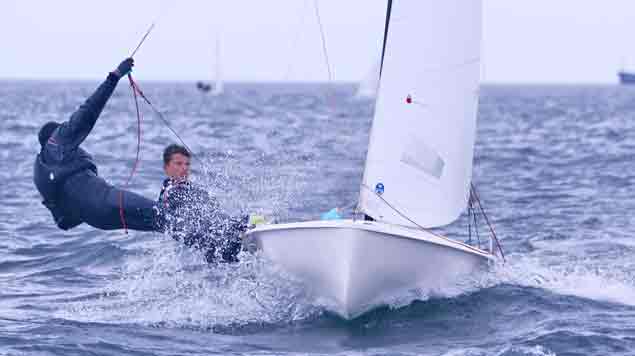 420 leaders Geoff Power James McCann from Waterford Harbour Sailing Club Photo: Simon McIlwaine
420 leaders Geoff Power James McCann from Waterford Harbour Sailing Club Photo: Simon McIlwaine
The Optimist fleet had four races today which tested all of the youngsters especially with a squall at the start of the last race with all but only a few getting too tired in the testing conditions to finish the last race.
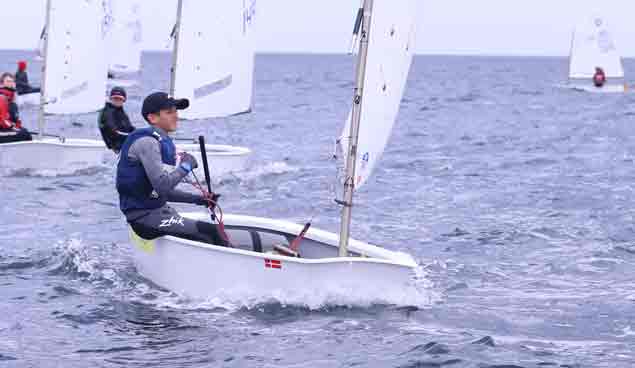 Optimist sailor Justin Lucas. Photo: Simon McIlwaine Photo: Simon McIlwaine
Optimist sailor Justin Lucas. Photo: Simon McIlwaine Photo: Simon McIlwaine
The Laser 4.7 fleet started their racing today with Sally Bell's younger brother Harry from Royal North Ireland winning the first race. Jack Fahy won the second race and Clare Gorman the last but the most consistent and now leads overall with a 4,2,1
 Clare Gorman of the National Yacht Club leads the Laser 4.7s Photo: Simon McIlwaine
Clare Gorman of the National Yacht Club leads the Laser 4.7s Photo: Simon McIlwaine
Another family affair, Jack Fahy's sister Kate showed great form in the Topper fleet which was also racing for their first day lying second overall from East Down's Sarah Jennings. Rob Keal won the first two races however and leads overall with 1,1,4. The Topper 4.2 fleet saw a local fight between Lewis Thompson, Hannah Dadley-Young and Josh McGregor with Lewis also getting 3 bullets for the day.
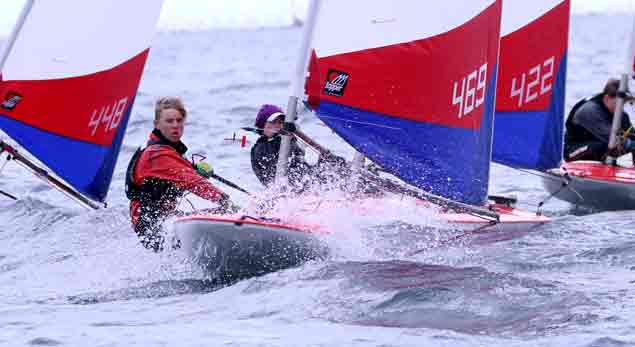 Rob Keal of Royal Cork is the Topper leader Photo: Simon McIlwaine
Rob Keal of Royal Cork is the Topper leader Photo: Simon McIlwaine
Full results are here. Optimist trials results may be found here.
In the evening, Rio Olympic Silver medallist Annalise Murphy gave the young audience some great reflections of her journey from the Optimist Trials through the various Pathway Championships in her Laser Radial and what it took to medal in Rio after the disappointments of London. There were lots of tidbits for the competitors to remember and Annalise revealed the level of commitment required with some of the extracts from her training diary started at the age of 13.
Day 3 of the racing starts tomorrow at 11:00 for all classes. The Championships finish on Sunday.
































